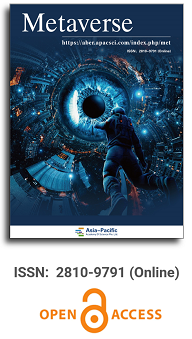
Asia Pacific Academy of Science Pte. Ltd. (APACSCI) specializes in international journal publishing. APACSCI adopts the open access publishing model and provides an important communication bridge for academic groups whose interest fields include engineering, technology, medicine, computer, mathematics, agriculture and forestry, and environment.



Mobile augmented reality: A pedagogical strategy in the university setting
Vol 1, Issue 2, 2020
Download PDF
Abstract
The mobile augmented reality (M-AR) besides being a booming computer technology is an innovative tool that can support the pedagogical process in university classrooms, that is why the present research aims to show a methodological proposal for its implementation, in order to facilitate the learning of spatial reasoning of students, through the visualization and manipulation of three-dimensional virtual objects, promoting the motivation of learning knowledge and topics of the course of industrial design and technical drawing for the career of industrial engineering. A collection of geometric figures has been elaborated with the help of technological tools such as 2D and 3D modeling software, computer-aided design software and augmented reality application software. An updated methodology is proposed, available to any teacher, oriented to the stimulation of mental processes related to spatial reasoning of students, which integrates technological tools in the didactics of the dihedral system and the different graphic projections.
Keywords
References
- Paredes C. The use of mobile devices in education: Augmented reality [Master’s thesis]. Spain: University of Valladolid; 2013.
- Font C. Development of spatial ability in technical drawing I students through augmented reality [Master’s thesis]. Spain: International University of La Rioja; 2015.
- Carracedo J, Martinez C. Augmented reality: A methodological alternative in Nicaraguan primary education. IEEE-RITA 2012; 7(2): 102–108.
- Fombona J, Pascual M, Ferreira M. Augmented reality, an evolution of mobile device applications. Pixel-B. Revista de Medios y Comunicació 2012; 41: 197–210.
- Moreno E, Pérez A. Augmented reality as a didactic resource for future teachers. Etic@Net 2017; 1(17): 42–59.
- Bower M, Howe C, McCredie N, et al. Augmented Reality in education—Cases, places and potentials. Educational Media International 2014; 51(1): 1–15.
- Ayala F, Blázquez E, Montes-Tubío F. Incorporation of 3D ICT elements into class: Augmented reality in graphic expression in engineering. Computer Applications in Engineering Education 2017; 25(3): 1–8.
- Cerqueira J, Clero B, Moura J, Sylla C (editors). Visualizing platonic solids with augmented reality. 17th ACM conference on interaction design and children; 2018 Jun; Thondheim.
- Garzon J, Acevedo J. Meta-analysis of the impact of Augmented Reality on students’ learning effectiveness. Educational Research Review 2019; 27: 244–260.
- Herpich F, Martins R, Fratin V, Rockenbach L. Augmented reality impact in the development of formal thinking. 4th Annual International Conference of the Immersive Learning Research Network (iLRN2018), Western Montana. 2018 Jun.
- Prendes C. Augmented reality and education: Analysis of practical experiences. Pixel-Bit-Revista de Medios y Educacion 2015; 46: 187–203.
- Ferguson R. Pedagogical innovations for technology-enabled learning. The Commonwealth of Learning, Burnaby, BC, Canada; 2019.
- Villalobos J. The teacher and teaching/learning activities: Some theoretical considerations and practical suggestions. Educere 2003; 7(22): 170–176.
- Vargas Z. Applied research: A way of knowing realities with scientific evidence. Education 2019; 33(1): 155–165.
- Sandí J, Cruz M. Methodological proposal for teaching and learning to innovate higher education. InterSedes 2016; 17(36): 153–189.
- Tristancho J, Vargas L, Contreras L. Evaluation of traditional techniques and ICT for the development of spatial skills in first semester students of industrial engineering. Revista Virtual Universidad Católica del Norte 2014; 43: 34–50.
- Cuendet S, Bonnard Q, Do-Lehn S, Dillenbourg P. Designing augmented reality for the classroom. Computers & Education 2013; 68: 557–569.
- Fernández A, Gacto M. Nuevas herramientas tecno-lógicas para la didáctica del dibujo técnico en bachille-rato (Spanish) [New technological tools for the didactics of technical drawing in high school]. Congreso Internacional de Innovación Docente, Spain; 2014.
- Merino C, Pino S, Meyer E, et al. Augmented reality to design teaching-learning sequences in chemistry. Educación Química 2015; 26(2): 94–99.
- Sánchez D. Didactic methodology in the area of graphic expression through parametric techniques and augmented reality [PhD thesis]. Spain: University of Extremadura; 2017.
- Blázquez A. Manual de Aumentaty: Herramienta de realidad aumentada (Spanish) [Aumentaty Manual: Augmented Reality augmented reality tool]. Universidad Politécnica de Madrid, Gabinete de tele-educación, Spain; 2018.
- Tovar L, Bohorquez J, Puello P. Methodological proposal for the construction of virtual learning objects based on augmented reality. Formación Universitaria 2014; 7(2): 11–20.
- Subramanian D, Kelly P. Effects of introducing innovative teaching methods in engineering classes: A case study on classes in an Indian university. Computer Applications in Engineering Education 2019; 27(1): 183–193.
- Ferrés P, Rivilla A, Vera-Gajardo N. Applied statistics: Validation of the Fischer, King, and Tague scale in engineering students. Revista Técnica de la Facultad de Ingeniería Universidad del Zulia 2019; Special Volume: 160–167.
- Wang M, Callaghan V, Bernhardt J, et al. Augmented reality in education and training: Pedagogical approaches and illustrative case studies. Journal of ambient intelligence and humanized computing 2017; 9(5): 1391–1402.
Supporting Agencies
Copyright (c) 2020 Luis Alberto Laurens Arredondo

This work is licensed under a Creative Commons Attribution 4.0 International License.

This site is licensed under a Creative Commons Attribution 4.0 International License (CC BY 4.0).

Prof. Zhigeng Pan
Professor, Hangzhou International Innovation Institute (H3I), Beihang University, China

Prof. Jianrong Tan
Academician, Chinese Academy of Engineering, China
Conference Time
December 15-18, 2025
Conference Venue
Hong Kong Convention and Exhibition Center (HKCEC)
...
Metaverse Scientist Forum No.3 was successfully held on April 22, 2025, from 19:00 to 20:30 (Beijing Time)...
We received the Scopus notification on April 19th, confirming that the journal has been successfully indexed by Scopus...
We are pleased to announce that we have updated the requirements for manuscript figures in the submission guidelines. Manuscripts submitted after April 15, 2025 are required to strictly adhere to the change. These updates are aimed at ensuring the highest quality of visual content in our publications and enhancing the overall readability and impact of your research. For more details, please find it in sumissions...






.jpg)
.jpg)

